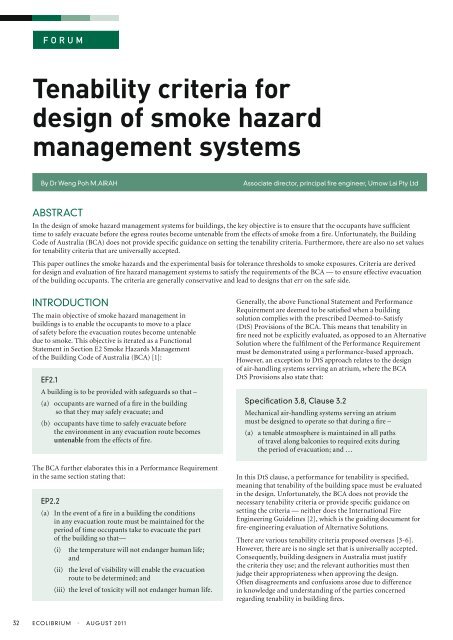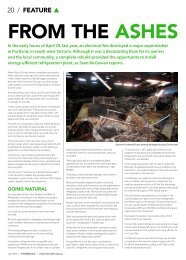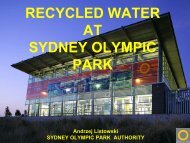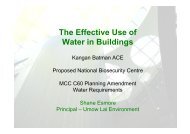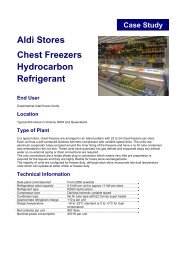Tenability criteria for design of smoke hazard management ... - Airah
Tenability criteria for design of smoke hazard management ... - Airah
Tenability criteria for design of smoke hazard management ... - Airah
Create successful ePaper yourself
Turn your PDF publications into a flip-book with our unique Google optimized e-Paper software.
32<br />
FORUM<br />
<strong>Tenability</strong> <strong>criteria</strong> <strong>for</strong><br />
<strong>design</strong> <strong>of</strong> <strong>smoke</strong> <strong>hazard</strong><br />
<strong>management</strong> systems<br />
by dr Weng Poh M.AiRAH Associate director, principal fire engineer, umow lai Pty ltd<br />
AbStRACt<br />
In the <strong>design</strong> <strong>of</strong> <strong>smoke</strong> <strong>hazard</strong> <strong>management</strong> systems <strong>for</strong> buildings, the key objective is to ensure that the occupants have sufficient<br />
time to safely evacuate be<strong>for</strong>e the egress routes become untenable from the effects <strong>of</strong> <strong>smoke</strong> from a fire. Un<strong>for</strong>tunately, the Building<br />
Code <strong>of</strong> Australia (BCA) does not provide specific guidance on setting the tenability <strong>criteria</strong>. Furthermore, there are also no set values<br />
<strong>for</strong> tenability <strong>criteria</strong> that are universally accepted.<br />
This paper outlines the <strong>smoke</strong> <strong>hazard</strong>s and the experimental basis <strong>for</strong> tolerance thresholds to <strong>smoke</strong> exposures. Criteria are derived<br />
<strong>for</strong> <strong>design</strong> and evaluation <strong>of</strong> fire <strong>hazard</strong> <strong>management</strong> systems to satisfy the requirements <strong>of</strong> the BCA — to ensure effective evacuation<br />
<strong>of</strong> the building occupants. The <strong>criteria</strong> are generally conservative and lead to <strong>design</strong>s that err on the safe side.<br />
iNtRoduCtioN<br />
The main objective <strong>of</strong> <strong>smoke</strong> <strong>hazard</strong> <strong>management</strong> in<br />
buildings is to enable the occupants to move to a place<br />
<strong>of</strong> safety be<strong>for</strong>e the evacuation routes become untenable<br />
due to <strong>smoke</strong>. This objective is iterated as a Functional<br />
Statement in Section E2 Smoke Hazards Management<br />
<strong>of</strong> the Building Code <strong>of</strong> Australia (BCA) [1]:<br />
ef2.1<br />
A building is to be provided with safeguards so that –<br />
(a) occupants are warned <strong>of</strong> a fire in the building<br />
so that they may safely evacuate; and<br />
(b) occupants have time to safely evacuate be<strong>for</strong>e<br />
the environment in any evacuation route becomes<br />
untenable from the effects <strong>of</strong> fire.<br />
The BCA further elaborates this in a Per<strong>for</strong>mance Requirement<br />
in the same section stating that:<br />
eP2.2<br />
(a) In the event <strong>of</strong> a fire in a building the conditions<br />
in any evacuation route must be maintained <strong>for</strong> the<br />
period <strong>of</strong> time occupants take to evacuate the part<br />
<strong>of</strong> the building so that—<br />
(i) the temperature will not endanger human life;<br />
and<br />
(ii) the level <strong>of</strong> visibility will enable the evacuation<br />
route to be determined; and<br />
(iii) the level <strong>of</strong> toxicity will not endanger human life.<br />
eColibRiuM • Augu St 2011<br />
Generally, the above Functional Statement and Per<strong>for</strong>mance<br />
Requirement are deemed to be satisfied when a building<br />
solution complies with the prescribed Deemed-to-Satisfy<br />
(DtS) Provisions <strong>of</strong> the BCA. This means that tenability in<br />
fire need not be explicitly evaluated, as opposed to an Alternative<br />
Solution where the fulfilment <strong>of</strong> the Per<strong>for</strong>mance Requirement<br />
must be demonstrated using a per<strong>for</strong>mance-based approach.<br />
However, an exception to DtS approach relates to the <strong>design</strong><br />
<strong>of</strong> air-handling systems serving an atrium, where the BCA<br />
DtS Provisions also state that:<br />
Specification 3.8, Clause 3.2<br />
Mechanical air-handling systems serving an atrium<br />
must be <strong>design</strong>ed to operate so that during a fire –<br />
(a) a tenable atmosphere is maintained in all paths<br />
<strong>of</strong> travel along balconies to required exits during<br />
the period <strong>of</strong> evacuation; and …<br />
In this DtS clause, a per<strong>for</strong>mance <strong>for</strong> tenability is specified,<br />
meaning that tenability <strong>of</strong> the building space must be evaluated<br />
in the <strong>design</strong>. Un<strong>for</strong>tunately, the BCA does not provide the<br />
necessary tenability <strong>criteria</strong> or provide specific guidance on<br />
setting the <strong>criteria</strong> — neither does the International Fire<br />
Engineering Guidelines [2], which is the guiding document <strong>for</strong><br />
fire-engineering evaluation <strong>of</strong> Alternative Solutions.<br />
There are various tenability <strong>criteria</strong> proposed overseas [3-6].<br />
However, there are is no single set that is universally accepted.<br />
Consequently, building <strong>design</strong>ers in Australia must justify<br />
the <strong>criteria</strong> they use; and the relevant authorities must then<br />
judge their appropriateness when approving the <strong>design</strong>.<br />
Often disagreements and confusions arose due to difference<br />
in knowledge and understanding <strong>of</strong> the parties concerned<br />
regarding tenability in building fires.
In order to assist building <strong>design</strong>ers better understand the<br />
subject, this paper outlines the background, <strong>design</strong> approaches<br />
and tenability <strong>criteria</strong> <strong>for</strong> <strong>design</strong> <strong>of</strong> <strong>smoke</strong> <strong>hazard</strong> <strong>management</strong><br />
systems.<br />
SMoke HAzARdS<br />
ANd teNAbility liMitS<br />
In the event <strong>of</strong> a building fire, the occupants may be<br />
exposed to the fire and <strong>smoke</strong>. Statistical evidence shows<br />
that most fire deaths are not caused by direct contact with<br />
the fire, but by <strong>smoke</strong> inhalation. While a fire may be confined<br />
to a localised area in a building, the <strong>smoke</strong> produced will rise,<br />
<strong>for</strong>ming a hot upper layer and may spread rapidly through the<br />
building. Hazards to the occupants include heat and toxic gases<br />
transported in the <strong>smoke</strong> and obscuration caused by the <strong>smoke</strong><br />
(see Figure 1).<br />
Figure 1: Hazards <strong>of</strong> Smoke from Building Fire<br />
Exposure to toxic gases or heat may cause incapacitation (loss <strong>of</strong><br />
consciousness); and severe exposure may cause death.<br />
The International Fire Engineering Guideline [2] defines<br />
untenable conditions as: “environmental conditions associated<br />
with a fire in which human life is not sustainable”, in other<br />
words, conditions that cause death. For the purpose <strong>of</strong> <strong>design</strong><br />
<strong>of</strong> <strong>smoke</strong> <strong>hazard</strong> <strong>management</strong> systems <strong>for</strong> safe evacuation, we<br />
consider that less severe conditions are more appropriate and<br />
tenability should be considered in terms <strong>of</strong> effective evacuation.<br />
Hence in the context <strong>of</strong> this paper, we consider tenability limits<br />
as exposure thresholds that cause incapacitation, injuries or<br />
ineffective evacuation movement.<br />
Purser [7] gives a comprehensive review <strong>of</strong> the <strong>smoke</strong> <strong>hazard</strong>s,<br />
including exposure thresholds that cause incapacitation and<br />
death. Some aspects <strong>of</strong> these are summarised below, with a focus<br />
on tenability limits <strong>for</strong> safe evacuation.<br />
Convected heat<br />
Prolonged exposure <strong>of</strong> more than 15 minutes to hot environments<br />
may cause heat stroke (hyperthermia). However, even <strong>for</strong> short<br />
durations, exposure to hot <strong>smoke</strong> at high temperatures may cause<br />
skin pain or skin and respiratory tract burns.<br />
In 1960s and 1980s, tests were conducted by various<br />
researchers [15 – 17] where people were subjected to dry, heated<br />
environments at temperatures ranging from 110°C to 180°C<br />
to determine the tolerance time to convected heat. These were<br />
later compiled and a curve was fitted to the results to <strong>for</strong>m the<br />
tolerance limits. The test results are shown in Figure 2 as circular<br />
dots together with fitted curve (red line).<br />
FORUM<br />
Figure 2: Tolerance to Convected Heat<br />
Human tolerance to dry heat is largely attributed to human’s<br />
ability <strong>of</strong> evaporative cooling through sweating [19]. Increased<br />
humidity in the air may limit evaporation and hence lower<br />
the tolerance time. However, there appears to be a paucity<br />
<strong>of</strong> test data on human tolerance in humid environments<br />
to temperatures above 45°C. Nevertheless, a relationship is<br />
proposed in [18] <strong>for</strong> estimating tolerance time to convected<br />
heat in water saturated environments. This relationship is<br />
shown Figure 2 as the blue line. In most fire situations, the air<br />
environment is relatively dry and unlikely to be fully saturated<br />
with water. In order to account <strong>for</strong> mid-humidity conditions,<br />
empirical relationship, which lies approximately between the<br />
dry and humid lines, is also proposed in [7].<br />
Radiant heat<br />
Even without direct contact with the hot <strong>smoke</strong>, skin pain or<br />
burns could still occur when exposed to high levels <strong>of</strong> radiant<br />
heat from the fire or the <strong>smoke</strong>. In the periods from 1950s to<br />
early 1980s, various tests [15, 16, 21, 22] were conducted to<br />
determine the tolerance time <strong>for</strong> radiant heat exposure to levels<br />
ranging from 2.4 kW/m2 to 23.5 kW/m2. The tolerance limits<br />
were later compiled and a curve fitted through the test results.<br />
The test results are shown in Figure 3 as circular dots together<br />
with fitted curve.<br />
Figure 3: Tolerance to Radiant Heat<br />
It is noted that the tolerance times in Figure 3 were obtained<br />
from radiant heat exposure to naked skin. It can be expected<br />
AuguSt 2011 • eColibRiuM<br />
33
34<br />
FORUM<br />
that the limits are higher with the protection <strong>of</strong> clothing. For<br />
example, field tests [8] were conducted where the author, with<br />
the protection <strong>of</strong> light clothing, exposed himself to radiant heat<br />
flux <strong>of</strong> 5.0 kW/m 2 <strong>for</strong> 30 s without suffering skin pain or burns.<br />
toxic gases<br />
In building fires, the most common asphyxiate is carbon<br />
monoxide (CO) and, to a lesser extent, hydrogen cyanide<br />
(CHN) which is more toxic. The exposure limits that cause<br />
incapacitation depend on the gas species, concentrations and<br />
durations <strong>of</strong> exposure. They were obtained from tests [7, 20]<br />
conducted on primates (juvenile baboons and cynomolgus<br />
monkeys) by subjecting them to various concentrations <strong>of</strong> CO<br />
and HCN. The results are shown Figure 4.<br />
eColibRiuM • Augu St 2011<br />
Figure 4: Tolerance to CO and HCN<br />
It is assumed that these limits are the same <strong>for</strong> humans.<br />
Loss <strong>of</strong> consciousness may also occur due to hypoxia at<br />
oxygen levels lower than 12%; or due to narcotic effects at<br />
carbon dioxide levels higher than 6%. However, it is considered<br />
that these conditions are unlikely to occur in building fire<br />
conditions [9, 10].<br />
Smoke obscuration<br />
Soot contained in <strong>smoke</strong> also obscures light and hence reduces<br />
visibility. Reduction in visibility is not directly life threatening<br />
such as heat or toxic gas exposure; however, it may reduce the<br />
walking speed <strong>of</strong> the occupants [11].<br />
Combustion gases in the <strong>smoke</strong> may also cause irritation<br />
to the eyes. These include acid gases (HF, HCl, HBr, SO2, NOx) and organic irritant gases (acrolein, <strong>for</strong>maldehyde, crotonaldehyde).<br />
Their effects have a similar effect to reduced visibility (see Figure 5).<br />
If the occupants are located at a significant distance from<br />
an exit and the visibility drops significantly, they may be unable<br />
to find their way out <strong>of</strong> the building. In either case, it may lead to<br />
an increased exposure time to heat and toxic gases which needs<br />
to be taken into account.<br />
deSigN APPRoACHeS<br />
Generally speaking, there are two main approaches to the <strong>design</strong><br />
<strong>of</strong> <strong>smoke</strong> <strong>hazard</strong> <strong>management</strong> systems. These are discussed below.<br />
No <strong>smoke</strong> exposure<br />
The first approach is to ensure that the occupants are not<br />
directly exposed to <strong>smoke</strong> — by keeping the <strong>smoke</strong> layer above<br />
the head height <strong>of</strong> the occupants. This height may be assumed<br />
to be 2.0m above the floor level, noting that the average heights<br />
<strong>of</strong> Australian adult males and females are 1.78m and 1.64m<br />
respectively [12]. This approach may be achieved by means<br />
<strong>of</strong> <strong>smoke</strong> exhaust, <strong>smoke</strong> venting, <strong>smoke</strong> containment or<br />
by ensuring that the occupants can quickly move out <strong>of</strong> the<br />
building (see Figure 6).<br />
Figure 6: Occupants not Exposed to Smoke<br />
The <strong>smoke</strong> exhaust systems prescribed by BCA Specification<br />
E2.2b are based on this approach, which requires the <strong>smoke</strong> layer<br />
to be maintained not less than 2.0m above the floor level.<br />
Smoke exposure<br />
In the second approach, it is assumed in the <strong>design</strong> that some<br />
<strong>of</strong> the occupants may need to move through tenable <strong>smoke</strong><br />
environments to evacuate the building (see Figure 7).<br />
teNAbility CRiteRiA<br />
Figure 5: Walking Speed versus Visibility<br />
Figure 7: Occupants Exposed to Smoke<br />
Irrespective <strong>of</strong> the <strong>design</strong> approach, the <strong>smoke</strong> <strong>hazard</strong><br />
<strong>management</strong> system must be evaluated against a set <strong>of</strong> <strong>criteria</strong> to<br />
ensure safe evacuation <strong>of</strong> the occupants. This may be achieved by<br />
assuming a <strong>design</strong> fire and analysing the fire environments and<br />
occupant evacuation. The fire environments may be analysed<br />
using zone models such as CFAST [12] or computational fluid
dynamics (CFD) models such as FDS [14]. Movement <strong>of</strong> the<br />
occupants may be evaluated using a separate evacuation analysis.<br />
The <strong>criteria</strong> to establish the tenability <strong>of</strong> the building space<br />
depend on the approach and the rigour <strong>of</strong> the analysis <strong>for</strong> the<br />
<strong>design</strong>. Three set <strong>of</strong> <strong>criteria</strong> are proposed in this paper to suit the<br />
<strong>design</strong> and evaluation approach. These are discussed below in<br />
order <strong>of</strong> increasing rigour <strong>of</strong> analyses.<br />
No exposure<br />
In situations where the occupants are not directly exposed to<br />
<strong>smoke</strong>, the tenability <strong>criteria</strong> are relatively simple (see Figure 8).<br />
The first criterion is to ensure the <strong>smoke</strong> layer is located above<br />
the head height; and the second criterion is to ensure that the<br />
radiant heat from the fire and the hot <strong>smoke</strong> layer above does not<br />
exceed the skin pain threshold <strong>of</strong> 2.5 KW/m2 (see Figure 3).<br />
Since the <strong>smoke</strong> is located above the head height <strong>of</strong> the<br />
occupants, convected heat and toxic gases <strong>of</strong> the <strong>smoke</strong> need not<br />
be considered. However, it is noted that the radiant heat limit <strong>of</strong><br />
2.5 KW/m2 may be reached when the hot layer temperature rises<br />
above 200°C.<br />
This method has an advantage that the <strong>criteria</strong> and evaluation<br />
are relatively simple. The <strong>smoke</strong> layer height and radiant heat<br />
may be calculated using a zone or CFD model, and there is no<br />
need to evaluate the convected heat, toxic gases and obscuration<br />
<strong>of</strong> the <strong>smoke</strong>.<br />
The world leading Swiss<br />
manufacturer <strong>of</strong> humidification<br />
products is pleased to continue<br />
its exclusive partnership in<br />
Australia with aireven<br />
(<strong>for</strong>merly Condair Australia).<br />
New name – same quality products and service<br />
www.aireven.com.au<br />
FORUM<br />
Figure 8: <strong>Tenability</strong> Criteria – No Exposure<br />
Short exposure<br />
For situations where the occupants may be exposed to <strong>smoke</strong> <strong>for</strong><br />
a short duration <strong>of</strong> up to 10 minutes, a simple set <strong>of</strong> <strong>criteria</strong> as<br />
shown in Figure 9 may be used.<br />
The <strong>criteria</strong> <strong>for</strong> convected heat and toxic gas exposures are<br />
obtained from tolerance limits in Figures 2–4, assuming<br />
a maximum 10-minute exposure. The air environment is<br />
conservatively assumed to be humid in establishing the tolerance<br />
to convective heat. The visibility limit <strong>of</strong> 10m is suitable <strong>for</strong> large<br />
AUSTRALIA<br />
HEATING SOLUTION PROFESSIONALS<br />
AuguSt 2011 • eColibRiuM<br />
35
36<br />
FORUM<br />
enclosures to assist occupant way finding. For small enclosure,<br />
a lower visibility limit <strong>of</strong> 5m may be used.<br />
For the sake <strong>of</strong> convenience, the <strong>smoke</strong> <strong>hazard</strong>s are evaluated at<br />
a height <strong>of</strong> 2.0m which, ironically, is above the head height <strong>of</strong> the<br />
occupants. This approach is conservative since the occupants are<br />
likely to be exposed to less severe conditions below the 2.0m height.<br />
Evaluation <strong>of</strong> the <strong>smoke</strong> <strong>hazard</strong>s at a lower height, say 1.5m, which<br />
is commonly regarded as the breathing zone, is equally valid.<br />
It is important to note that the convected heat and toxicity<br />
<strong>criteria</strong> are derived from tenability limits <strong>for</strong> constant exposures<br />
to the limiting values over the entire exposure period. For<br />
example, the criterion <strong>for</strong> convected heat represents the tolerance<br />
limit <strong>for</strong> a constant 10-minute exposure to 100°C. However,<br />
in a fire condition, the occupants are likely to be exposed to<br />
continual changing environments where the temperature<br />
increases with time until it reaches 100°C when it is considered<br />
untenable using this method. Such exposure is less severe than<br />
the constant exposure to 100°C over the entire period. From this<br />
viewpoint, this, and similarity the <strong>criteria</strong> <strong>for</strong> toxic gas exposure,<br />
are generally conservative.<br />
The method described here requires each <strong>smoke</strong> <strong>hazard</strong> to<br />
be calculated <strong>for</strong> the period while the occupants evacuate<br />
the building. The <strong>criteria</strong> are relatively easy to apply, since<br />
each <strong>hazard</strong> needs to be checked independently against one<br />
corresponding limit.<br />
general exposure<br />
For situations where the occupants may be exposed to <strong>smoke</strong><br />
<strong>for</strong> a longer duration <strong>of</strong> up to 30 minutes, a more general and<br />
rigorous analysis using Fractional Effective Dose (FED) method<br />
[7, 10] may be used to evaluate the tenability conditions.<br />
The FED method involves the determination <strong>of</strong> exposure doses<br />
at regular discrete time increments and summing the exposure<br />
doses to get the cumulative dosage <strong>for</strong> the total period <strong>of</strong><br />
exposure. The doses are calculated as a fraction <strong>of</strong> incapacitation<br />
dosage, and hence the maximum value <strong>of</strong> FED =1.0 represents<br />
the state <strong>of</strong> incapacitation.<br />
Heat exposure is calculated as a FED, taking into account the<br />
combined effects <strong>of</strong> convected and radiant heat. Toxic gas<br />
exposure is calculated as another FED, taking into account the<br />
combined effects <strong>of</strong> the relevant gases. The effects <strong>of</strong> varying O2 and CO2 may also be included in the calculation [7]. Using this<br />
method, the tenability <strong>criteria</strong> are shown in Figure 10.<br />
eColibRiuM • Augu St 2011<br />
Figure 9: <strong>Tenability</strong> Criteria – Short Exposure Figure 10: <strong>Tenability</strong> Criteria – General Exposure<br />
Again, <strong>for</strong> the sake <strong>of</strong> convenience, the FEDs are evaluated at the<br />
height <strong>of</strong> 2.0m; although, as discussed in the previous section,<br />
they may be equally valid to evaluate them at a lower height <strong>of</strong><br />
1.5m.<br />
The same approach may also be used to determine the fractional<br />
effective concentration (FEC) <strong>of</strong> combustion gases that cause<br />
irritation to the eyes and respiratory tracts, including acid gases<br />
(HF, HCl, HBr, SO2, NOx) and organic irritant gases (acrolein,<br />
<strong>for</strong>maldehyde, crotonaldehyde). The FEC may be used to modify<br />
the walking speed <strong>of</strong> the occupants, where FEC = 1.0 represents<br />
incapacitation or cessation <strong>of</strong> effective evacuation movement.<br />
The FED method has the advantage that it takes into account<br />
the variation <strong>of</strong> the exposure environments with time and the<br />
combined effects <strong>of</strong> the exposures to various effects <strong>of</strong> the fire.<br />
It is particularity useful <strong>for</strong> situations where the occupants are<br />
exposed to low doses over a long period <strong>of</strong> time, or to high doses<br />
over a short period <strong>of</strong> time. This may lead to a more cost effective<br />
<strong>design</strong> <strong>of</strong> the <strong>smoke</strong> <strong>management</strong> system.<br />
To date, this method has not been as widely used in <strong>design</strong>.<br />
However, it is envisaged it will gain popularity when more<br />
comprehensive FED calculations are incorporated into analysis<br />
programs such as CFAST and FDS.<br />
CoNCluSioNS<br />
This paper outlined the <strong>smoke</strong> <strong>hazard</strong>s and the experimental<br />
basis that was used to derive the tenability limits <strong>for</strong> occupants<br />
to safely evacuate buildings in the event <strong>of</strong> a fire. Approaches <strong>for</strong><br />
<strong>design</strong> and evaluation <strong>of</strong> <strong>smoke</strong> <strong>hazard</strong> <strong>management</strong> systems<br />
were also discussed.<br />
Based on the tenability limits, <strong>criteria</strong> were given <strong>for</strong> different<br />
approaches <strong>for</strong> <strong>design</strong> and evaluation. These include:<br />
No exposure:<br />
• <strong>smoke</strong> layer height ≥ 2.0m<br />
• radiant heat ≤ 2.5 kW/m 2<br />
Short exposure (up to 10 minutes)<br />
– conditions at 2.0m height:<br />
• radiant heat ≤ 2.5 kW/m2 • air temperature ≤ 100°C<br />
• CO level ≤ 2,800 ppm
• HCN ≤ 140 ppm<br />
• Visibility ≥ 10 m (large enclosures); ≥ 5 m (small enclosures)<br />
general exposure (up to 30 minutes)<br />
– conditions at 2.0m height:<br />
• FED <strong>for</strong> toxic gases < 1.0<br />
• FED <strong>for</strong> heat < 1.0<br />
These <strong>criteria</strong> may be used <strong>for</strong> <strong>design</strong> <strong>of</strong> <strong>smoke</strong> <strong>hazard</strong><br />
<strong>management</strong> systems to satisfy the requirements <strong>of</strong> the BCA.<br />
They are generally conservative and lead to <strong>design</strong>s that err on<br />
the safe side. ❚<br />
RefeReNCeS<br />
[1] “National Construction Code Series, Volume One,<br />
Building Code <strong>of</strong> Australia 2011 —Class 2 to 9 Buildings”,<br />
Australian Building Codes Board, 2011.<br />
[2] “International Fire Engineering Guidelines”, Australian<br />
Building Codes Board, 2005.<br />
[3] Fire Engineering, CIBSE Guide E, 3rd ed., The Chartered<br />
Institution <strong>of</strong> Building Services Engineers, 2010.<br />
[4] Buchannan, A.H., “Fire Engineering Design Guide, 2nd<br />
Edition”, Centre <strong>for</strong> Advanced Engineering, Christchurch,<br />
New Zealand, April 2001.<br />
[5] “European Guideline CFPA-E No 19, Fire Safety<br />
Engineering Concerning Evacuation from Buildings”<br />
CFPA Europe, Stockholm, 2009.<br />
[6] Hadjisophocleous, G. V., and Benichou, N., “Per<strong>for</strong>mance<br />
Criteria Used in Fire Safety Design’, Automation in<br />
Construction, 8, 1999, pp 489–501.<br />
[7] Purser, D.A., “Assessment <strong>of</strong> Hazards to Occupants from<br />
Smoke, Toxic Gases and Heat”, The SFPE Handbook <strong>of</strong><br />
Fire Protection Engineering 4th ed), DiNenno P.J (ed.),<br />
National Fire Protection Association, Quincy, MA 02269,<br />
2009, pp. 2/96 – 2/193.<br />
[8] Raj, P.K., “Field Tests on Human Tolerance to (LNG)<br />
Fire Radiant Heat Exposure, and Attenuation Effects<br />
<strong>of</strong> Clothing and Other Objects”, Journal <strong>of</strong> Hazardous<br />
Materials, 157, 2008, pp 247–259.<br />
[9] “ATS 5387.8, Australian Technical Specification. Guidelines<br />
– Fire Safety Engineering. Part 8: Life Safety – Occupant<br />
Behaviour, Location and Condition”, Standards Australia,<br />
2006.<br />
[10] “ISO 13571, Life-threatening Components <strong>of</strong> Fire –<br />
Guidelines <strong>for</strong> the Estimation <strong>of</strong> Time Available <strong>for</strong> Escape<br />
Using Fire Data”, The International Organization <strong>for</strong><br />
Standardization, 2007.<br />
[11] Milke, J. and Klote, H., “Smoke Management in Large<br />
Spaces in Buildings”, Building Control Commission <strong>of</strong><br />
Victoria, 1998.<br />
[12] “National Health Survey: Summary <strong>of</strong> Results”, Australian<br />
Bureau <strong>of</strong> Statistics, Commonwealth <strong>of</strong> Australia,<br />
Canberra, 2005.<br />
FORUM<br />
[13] Peacock, R.D., Jones, W.E, Reneke, P.A. and Forne, G.P.,<br />
“CFAST–Consolidated Model <strong>of</strong> Fire Growth and Smoke<br />
Transport (Version6) User’s Guide”, National Institute <strong>of</strong><br />
Standards and Technology, NIST Special Publication 1041,<br />
2008.<br />
[14] McGrattan, K, B., Forney, G. P., Floyd, J. F, Hostikka,<br />
D., Prasad, K. “Fire Dynamic Simulator – User’s Guide”,<br />
National Institute <strong>of</strong> Standards and Technology, NIST<br />
6784, 2002.<br />
[15] Simms, D.L., and Hinkley, P.L., “Protective Clothing<br />
against Flames and Heat”, Fire Research Report No. 3., Her<br />
Majesty Stationary Office, London, 1963.<br />
[16] Veghte, J.H, Fire Service Today, 49, p.16, 1982.<br />
[17] Elneil, H., “Man in Hot and Cold Environments,” A<br />
Companion to Medical Studies, Blackwell, Ox<strong>for</strong>d, UK, pp.<br />
40.1-40.7, 1968.<br />
[18] Blockley, W.V., “Temperature Tolerance: Man: Part 1.<br />
Heat and Cold Toleranace with and without Protective<br />
Clothing”, Biology Data Book, Federation <strong>of</strong> American<br />
Societies <strong>for</strong> Experimental Biology, Bethesda, MD, p 781,<br />
1973.<br />
[19] Kenney, W.L,,DeGroot, D.W., Holowatz, L.A, “Extremes<br />
<strong>of</strong> Human Heat Tolerance: Life at the Precipice <strong>of</strong><br />
Thermoregulatory Failure,” Journal <strong>of</strong> Thermal Biology 29,<br />
p 479–485, 2004.<br />
[20] Kaplan, H. L., Grand, A. F., Switzer, W. G., Mitchell, D. S.,<br />
Rogers, W. R. And Hartzell, G. E., “Effects <strong>of</strong> Combustion<br />
Gases on Escape Per<strong>for</strong>mance <strong>of</strong> the Baboon and the Rat”,<br />
J. Fire Sciences, 3 (4), pp. 228-244, 1985.<br />
[21] Buettner, K., “Effects <strong>of</strong> Extreme Heat and Cold on Human<br />
Skin. II. Surface Temperature, Pain and Heat Conductivity<br />
in Experiments with Radiant Heat”, Journal <strong>of</strong> Applied<br />
Physiology, 3, p 703-713, 1951.<br />
[22] Dinman, B.D, Journal <strong>of</strong> the American Medical<br />
Association, 235, p. 2874, 1968.<br />
About tHe AutHoR<br />
Dr Weng Poh is an associate director and the head <strong>of</strong><br />
the fire engineering group at umow Lai. Throughout<br />
his career, Weng has completed numerous fire<br />
engineering projects. He has been closely involved<br />
in the development <strong>of</strong> methodology <strong>for</strong> fire safety<br />
<strong>design</strong>s <strong>of</strong> buildings in Australia and has published<br />
extensively in international journals, conferences<br />
and technical reports. Weng also gives lectures in<br />
postgraduate courses, aimed at training building<br />
practitioners in fire engineering <strong>design</strong>.<br />
AuguSt 2011 • eColibRiuM<br />
37


